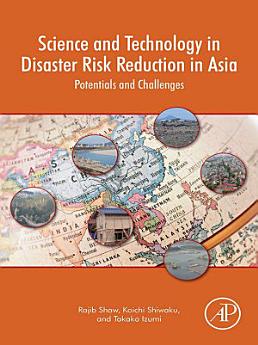Science and Technology in Disaster Risk Reduction in Asia: Potentials and Challenges
About this ebook
About the author
Dr. Rajib Shaw is a professor at Keio University's Graduate School of Media and Governance. He is also the Chairperson of SEEDS Asia and CWS Japan, two Japanese NGOs, and a Senior Fellow of the Institute of Global Environmental Strategies (IGES) Japan. He was previously the Executive Director of the Integrated Research on Disaster Risk (IRDR) and a Kyoto University Professor. Disaster governance, community-based disaster risk management, climate change adaptation, urban risk management, and disaster and environmental education are all areas of interest for him. Professor Shaw is the Chair of the UN Science Technology Advisory Group for Disaster Risk Reduction (STAG) and the Co-Chair of the Asia Science Technology Academic Advisory Group (ASTAAG). He's also the CLA (Coordinating Lead Author) for the IPCC's 6th Assessment Report's Asia chapter. He is the editor-in-chief of the journal "Progress in Disaster Science" published by Elsevier, as well as the series editor of a Springer book series on disaster risk reduction. Prof. Shaw has over 45 books to his credit, as well as over 300 scholarly papers and book chapters.
Koichi Shiwaku is a Researcher in the Graduate School of Global Environmental Studies of Kyoto University, Japan. He has been working with central and local governments, NGOs, school teachers and students, and local communities in Japan and overseas countries. His recent works are enhancing school disaster resilience and capacity development of officers of board of education in the area affected by the 2011 Great East Japan Earthquake. His research interests are disaster education, community based disaster risk management, governance for disaster education, school safety, and capacity development of local government.
Takako Izumi is an Associate Professor in the International Research Institute of Disaster Science (IRIDeS), Tohoku University in Japan. She also serves as Programme Coordinator of the Multi-Hazards Programme under the Association of Pacific Lim Universities (APRU) that consists of 45 universities and academic institutes in the Pacific Lim. Her research interests include international and regional framework of disaster risk reduction, disaster risk reduction at local level, and role of civil society in disaster management. Previously, she worked for the UN Office for the Coordination of Humanitarian Affairs (UNOCHA) for the disaster response coordination in Asia and for one of the international NGOs in Malaysia as General Manager to oversee the programs of disaster response and disaster risk reduction.






